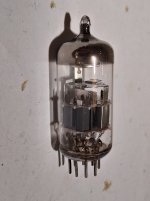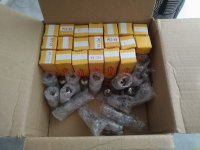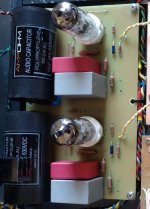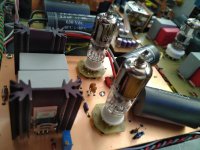They are not the same tube and can not be swapped in the circuitry if made for one of this tube OR the other...but if the circuitry is dev from the beginning for that. The heater have not the same current cunsumption also.
The e88cc has not mica for instance if I am correct so is less quiet.
Look at the numbers you already know one support 220v the other 130V. Ok curves are close as I have said close brothers. But not the same.
6922 usa said equivalent is 150V so not the same exactly than e88cc...etc.
Ecc88 was more used in calculators and telecom switching circuitries and the ecc88 for demodulation of tv for illustration in the golden days of Philips.
But hey you all know what you hear what is essential is to be happy at the end of the day. I imagine a hardly sorted out e88cc with the good curve area chosen by the rigth tech can sound ok. But I surmise a same year and same planr ecc88 will the quieter and the e188cc (and the others e288cc etc) will blur both e88cc and ecc88 on the noise side. Not saying they will not last the same if swappung one for the others in relation for which one was developped the circuitry.
The e88cc has not mica for instance if I am correct so is less quiet.
Look at the numbers you already know one support 220v the other 130V. Ok curves are close as I have said close brothers. But not the same.
6922 usa said equivalent is 150V so not the same exactly than e88cc...etc.
Ecc88 was more used in calculators and telecom switching circuitries and the ecc88 for demodulation of tv for illustration in the golden days of Philips.
But hey you all know what you hear what is essential is to be happy at the end of the day. I imagine a hardly sorted out e88cc with the good curve area chosen by the rigth tech can sound ok. But I surmise a same year and same planr ecc88 will the quieter and the e188cc (and the others e288cc etc) will blur both e88cc and ecc88 on the noise side. Not saying they will not last the same if swappung one for the others in relation for which one was developped the circuitry.
Last edited:
A native speaker cannot understand everything about the tube. I have a friend who told me for the first time about the higher sound quality. EI...e88cc...than...Siemens. Check to see if his equipment is enough to validate this diagnosis?I think I readed it well as it was in my native language. Here in Europe all tubes amateurs knows the 3 top countries that worked with good workers and good daily care on the machines were Holland, France and Germany.
Frankly no one want to buy Ei here. That certainly does not say some years have good productions I imagine. I have an E188CC made in France (there were 2 or 3 philips plants iirc)...it sounds better than some Telefunken and Siemens. But voila, there was a hype from the usa enthusiasts on german brands just because they do not know really about off shore. And indeed as a good no sq tubes thoses e88cc are the less quiet for audio of the 3 close brothers (ecc88, e188cc) as a good industrial tube ....made in big quantity. Brands developped audio gears with the e88cc because they were easily avialable lately. They needed what ? 50 tubes before sorting out 2 half triodes that was close and charged the customers...Audio research Conrad J. And so on.
Mine is less than 5% matched from the factory and no microphonics.
Keep your Ei. What I readed is Ei worked on less good russian tools as an east europe based country and they just purchased lately old philips tools no good anymore for west europe standard. There was a wall...remember.
Last edited:
Maybe you believed it cause your friend, I do not know ! I do not see what the picture is proving but if biased by your wallet and marketing. It is not a Shinndo or gears made with NOS tube before the 70/75s tubes if I have identified those 2 gears well. They are more modern production with modern remade western tubes in chineese or russian plants.
Well sorry to have highjacked the thread, not my intention, I quite. You have audio research with e88cc that sounds not bad but also a lot of marketing behind and the price you spent biass you. Anyway if Audio Research had access easily in good quantity of ECC88 or E188cc for all the production they had done it. At least this is what i reded elswhere with guys having collected all the tubes from Earth and understanding perfectly what they do and how tubes are made with the rulling of these changes whatever the years and the plants. It is a business, that's why you saw e88cc poping everywhere cause tubes was sexy and gears could be sold expensive. The most honnest corted out their gears with good NOS tube, but hey who has the incomes for a 5 digit hifi gear ?!
So you have a hype and the guys go with bad tubes in their mancave to try to do it the cheap ways and it often sounds terrible (others diyers with the knowledge know what they do cause documented and can control tube with fine measuring and find the good tubes - edit I am not in than camp cause I can not affoard -)
Well sorry to have highjacked the thread, not my intention, I quite. You have audio research with e88cc that sounds not bad but also a lot of marketing behind and the price you spent biass you. Anyway if Audio Research had access easily in good quantity of ECC88 or E188cc for all the production they had done it. At least this is what i reded elswhere with guys having collected all the tubes from Earth and understanding perfectly what they do and how tubes are made with the rulling of these changes whatever the years and the plants. It is a business, that's why you saw e88cc poping everywhere cause tubes was sexy and gears could be sold expensive. The most honnest corted out their gears with good NOS tube, but hey who has the incomes for a 5 digit hifi gear ?!
So you have a hype and the guys go with bad tubes in their mancave to try to do it the cheap ways and it often sounds terrible (others diyers with the knowledge know what they do cause documented and can control tube with fine measuring and find the good tubes - edit I am not in than camp cause I can not affoard -)
Last edited:
it is rebrand. EI very popular when american and western european tube factories quit prodution but kept selling and rebranding. EI was independent not philips factory. they had some philips tooling--look at the glass.E88CC is not a good tube for audio (and not made for that iirc. ECC88 or E188CC are.
I have read Ei purchased old production machinery from Philips Holland and elswhere. As the machinery was old second hand and Ei produce indeed latelyy tubes with them, those tubes was not said to be very good and nowhere a true equivalent of the older made in Holland Germany and France with Philips machinery.
If a Philips made by a Philips factory, there should be a factory logo, like the Delta and so on, no ?
This looks like a rebadged tube perhaps....
EI they bought telefunken tooling and made their own smooth plate ecc83 on the very same tooling TF ulm made their ECC83 smooth plate.
E88CC is just selected ECC88 for better symmetry. I also heard (not sure if true or not) that the better half of the ECC88 was burnt in the factory until its parameters (mu?) were reduced to those of the worse half. After this procedure it was badged as E88CC. Might be an urban legend.
tubes came back, money-loving people hunted . and sold them more expensively. For me, tubes are sacred. They are a reminder of human effort. An effort that was able to make strange changes in people's lives. When television came to the market, one of the challenges The stability was in the receiver. Somewhere with high frequency radio circuits. Look at the picture of pcc88 used to amplify the antenna signal. A frame grid with different film in cascode mode. I worked in Panasonic TV department for ten years. I did. Circuits with compact SMD components. But when I look at the tubes, with circuits similar to the electrical wiring of an old automobile... I am surprised. How does such a thing work accurately?Attachments
You may only value your own thoughts and consider other people's experiences to be influenced by commercial advertisements. But we have to accept that human ears are almost like other ears as long as they are not damaged.. Our brains are the same in understanding the pleasure of music. Yes, almost. If we drink alcohol, we don't have much difference. This picture shows that it is paid for to hear a better voice. Many people do not notice the difference in the sound of the tubes... because of the low quality in their equipment. There are speakers that do not show the difference in the sound of the tubes. I have seen these. Or how do you know when your player is never able to play the details? ......plays the details? My friend has a Rogers 3.5 speaker and spent a lot of money to collect music records and good cables...he buys tubes from England for Leben amplifier. ..and his own Audio net player. Every time he buys an amplifier, he looks for the best response of the tubes He believes that the sound of ei e88cc is better than simens e88cc .. I also tested it many times. He was right. Philips tubes are like this. Of course, not all of them...Maybe you believed it cause your friend, I do not know ! I do not see what the picture is proving
Yeah.it is rebrand. EI very popular when american and western european tube factories quit prodution but kept selling and rebranding. EI was independent not philips factory. they had some philips tooling--look at the glass.
EI they bought telefunken tooling and made their own smooth plate ecc83 on the very same tooling TF ulm made their ECC83 smooth plate.
they come lately with second hand used philips tooling too. Hence the production was less good in specs. Maybe quality control was less good too as the prices less expensive.
I am not sure but i have read the half disymetrie of the e88cc was worse than the ecc88 which is not good as well. After all they were not dev for stereo audio.
ECC88 and E88CC are different tubes.
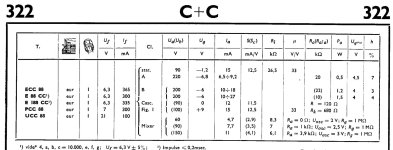
For example E88CC datasheet define positive grid voltage curves, ECC88 not.
Curves are similar, but not exactly the same.
Substituting ECC88 with E88CC is possible (slightly different If), the opposite is depends of the design (mainly Ua).
p.s.
E88CC/6922 equivalent noise resistance is 240R, ECC88/6DJ8 has 300.

For example E88CC datasheet define positive grid voltage curves, ECC88 not.
Curves are similar, but not exactly the same.
Substituting ECC88 with E88CC is possible (slightly different If), the opposite is depends of the design (mainly Ua).
p.s.
E88CC/6922 equivalent noise resistance is 240R, ECC88/6DJ8 has 300.
Last edited:
Working Triodes that are in a good circuit, that has the proper quiescent voltages and currents, proper plate load, and is used within the dynamic range of the tube and circuit . . .
They sound real good.
Working Triodes that are in a bad circuit, that has improper quiescent voltages and currents, improper plate load, and is used beyond the dynamic range of the tube and circuit . . .
They sound real bad.
Just a Generalization.
"All Generalizations have exceptions." - me
They sound real good.
Working Triodes that are in a bad circuit, that has improper quiescent voltages and currents, improper plate load, and is used beyond the dynamic range of the tube and circuit . . .
They sound real bad.
Just a Generalization.
"All Generalizations have exceptions." - me
Unfortunately, I have to correct you again, I guess I know the history of my former country much better than you do.I think I readed it well as it was in my native language. Here in Europe all tubes amateurs knows the 3 top countries that worked with good workers and good daily care on the machines were Holland, France and Germany.
Frankly no one want to buy Ei here. That certainly does not say some years have good productions I imagine. I have an E188CC made in France (there were 2 or 3 philips plants iirc)...it sounds better than some Telefunken and Siemens. But voila, there was a hype from the usa enthusiasts on german brands just because they do not know really about off shore. And indeed as a good no sq tubes thoses e88cc are the less quiet for audio of the 3 close brothers (ecc88, e188cc) as a good industrial tube ....made in big quantity. Brands developped audio gears with the e88cc because they were easily avialable lately. They needed what ? 50 tubes before sorting out 2 half triodes that was close and charged the customers...Audio research Conrad J. And so on.
Mine is less than 5% matched from the factory and no microphonics.
Keep your Ei. What I readed is Ei worked on less good russian tools as an east europe based country and they just purchased lately old philips tools no good anymore for west europe standard. There was a wall...remember.
In the same year that Ei started working there was a rift between Stalin and Tito and it is impossible that Ei received russian tools then, on the contrary the West then decided to sponsor Tito and that's why Philips partially entered Ei like many other Western companies that got partners in the former Yugoslavia. All tubes made in Ei are made on original Philips tools with their material even the boxes are made in Philips with the Ei logo.
This is the reason why tubes with western markings and manufacturers have always been used in Yugoslavia, just as Yugoslavia never fell behind the Iron Curtain.
As for the sound of Ei tubes, I'm sorry that you're disappointed, it seems to me that the better tubes ended up among collectors from the countries of the former Yugoslavia while the worse ones were sold on ebay and elsewhere. Sonically, they are no worse than Philips or Siemens, while some tubes are even better. It is known that the final control was somewhat worse, but I can easily find a pair among my samples if I need them as was the case with the Ei ECC88 that I used in WCF.
As for the E88CC, I'm not sure that Ei ever produced it, I've seen 6DJ8 Elites, but I've never seen an Ei E88CC.
And I forgot, in the first picture are tube from which manufacturer?
Attachments
Last edited:
I am sure you know the history of your country better than I, for sure. Far complex history btw.
Did they have russian tooling before that ? What was the year they introduced Philips tooling ? brand new tooling or second hand plant from Holland or elsewhere in Europe ? The year Philips entered in the Ei capital ?
There certainly is a year where the production becomes less good at Ei ? have you experienced a year where it became less good or was good till the 80s ?
Here there were Valvo, RT, and I forgot certainly many other brand that was made by Philips in France, but also some french Philips tubes badged for local market were made in Heerlen Holland. That's how I get a NIB E188CC french brand for national radio and TV but made in Holland in 1972 while this tube was also made in France ! If I am not wrong we also fabed some Mazda tubes !
Did they have russian tooling before that ? What was the year they introduced Philips tooling ? brand new tooling or second hand plant from Holland or elsewhere in Europe ? The year Philips entered in the Ei capital ?
There certainly is a year where the production becomes less good at Ei ? have you experienced a year where it became less good or was good till the 80s ?
Here there were Valvo, RT, and I forgot certainly many other brand that was made by Philips in France, but also some french Philips tubes badged for local market were made in Heerlen Holland. That's how I get a NIB E188CC french brand for national radio and TV but made in Holland in 1972 while this tube was also made in France ! If I am not wrong we also fabed some Mazda tubes !
Last edited:
Ei never had russian tooling and Philips tooling were new, production started in 1948 under the supervision of Philips .
The best years of the company were until the beginning of the 80s.
The best years of the company were until the beginning of the 80s.
While we are at it, which company "invented" (or patented) the E88CC first? Did all other factories licensed from that company? What about the assembly lines? Did all factories develop their own according to the original specs, or also purchased from the root source? I guess Philips was it, but I am not sure.
I think you need the tooling so an agreement. Some parts sometimes was comming from Holland for the assembly plants abroad.
There were economical versions too made under licence and known to sound less good as the ECC88 like sold by Siemens with different getter, spacing, etc... Do not tell it to all the merchandts that put butter in their spinach with the "made in Germany" argument.
As least it is what I have read on a french forums where the tube culture is as vivid as Japan or USA from a very long time. Some plants had old tooling too or were not knew for their assembly quality like (Ei... I joke) Blackburn GB, for instance. Fo the ones reading french there are some good books about tubes origins by plants from Jean Hirage or Francis Ibre for instance.
Amperex in US was good for illustration and some were directly made directly at Heerlen Netherland as well as the packaging.
There were economical versions too made under licence and known to sound less good as the ECC88 like sold by Siemens with different getter, spacing, etc... Do not tell it to all the merchandts that put butter in their spinach with the "made in Germany" argument.
As least it is what I have read on a french forums where the tube culture is as vivid as Japan or USA from a very long time. Some plants had old tooling too or were not knew for their assembly quality like (Ei... I joke) Blackburn GB, for instance. Fo the ones reading french there are some good books about tubes origins by plants from Jean Hirage or Francis Ibre for instance.
Amperex in US was good for illustration and some were directly made directly at Heerlen Netherland as well as the packaging.
Last edited:
The E88CC was not a super ECC88, audio/vhf/uhf wise at least. E88CC was just a less quiet ECC88 (so more noisy and microphonic) but SQ tube (10 000 h) for comutation pirpose and the dispersion between the two hal triodes is even worse than the ECC88. The super ECC88 for our purpose is the the E188CC (7308 named in US) ( quieter and long life, appaired 5% max from the plant).
Amperex made both ECC88 and 6DJ8 (american name of the licencied ECC88 invented by Philips)
Some company stamped Philips had no Philips tooling. And some Philips tooling were given to some company for the production to be continued like Ei (Yougoslavia) or Polam (Poland). (I transcript from a french Forum). There was not Philips tooling elswhere from Holland before 1958. Ei had Telefunken tools and only after Philips tooling (lately as far I have read from a guy that written several book about tubes). So some ECC88 were made with Telefunken tools under licence. And Siemens too, known as the worst(least quiet/ no mica, for economical reason), so with their own tooling).
So 6DJ8 equals not E88CC (6922) And Wikipedia is not Britanica or Universalis Encyclopedia. There are a lot of things on Wikipedia written by students not rulling their subject and writting false verity. Or at least the word "versions" is confusing. Well it is free, you got what you got.
Amperex made both ECC88 and 6DJ8 (american name of the licencied ECC88 invented by Philips)
Some company stamped Philips had no Philips tooling. And some Philips tooling were given to some company for the production to be continued like Ei (Yougoslavia) or Polam (Poland). (I transcript from a french Forum). There was not Philips tooling elswhere from Holland before 1958. Ei had Telefunken tools and only after Philips tooling (lately as far I have read from a guy that written several book about tubes). So some ECC88 were made with Telefunken tools under licence. And Siemens too, known as the worst(least quiet/ no mica, for economical reason), so with their own tooling).
So 6DJ8 equals not E88CC (6922) And Wikipedia is not Britanica or Universalis Encyclopedia. There are a lot of things on Wikipedia written by students not rulling their subject and writting false verity. Or at least the word "versions" is confusing. Well it is free, you got what you got.
Last edited:
Not saying some little joker like Mullard sometimes stamped E189CC as ECC88 or made lately out of spec ECC88 ! Ah, same with their RTC... those britanics 😉 !
Wikipedia isn't absolutely right here. I have some evidence (an article published in the German magazine FUNKSCHAU in early 1954) that E88CC was first in this row. TV manufacturers found out that this tube outperformed the PCC84 in terms of noise and amplification that has been used as the 1st Cascode amplifier in TV frontends until then. Anyway, the E88CC`s SQ property led to other issues in TV's, mostly in terms of warranty etc. So, tube manufacturers developed the PCC88 as a consumer tube with nearly the same performance. Next was ECC88.Looks like it was Philips according to this short and sweet summary on Wikipedia.
Best regards!
- Home
- Amplifiers
- Tubes / Valves
- EI E88CC...

